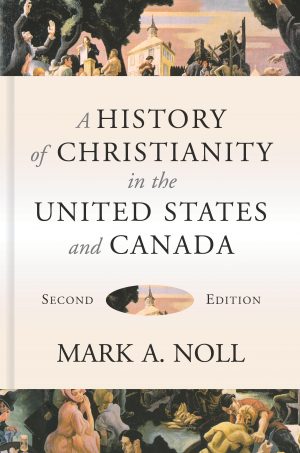When first published in 1992, Mark A. Noll’s A History of Christianity in the United States and Canada quickly established itself as one of the best, if not the best, treatments of the subject. The second edition of that book revises, updates, and adds to the original text. Its length (592 pages) and price ($55.00) will limit its readership to scholars and students in undergraduate and graduate institutions, who are likely its intended demographic. As a Christian minister in the U.S., however, I heartily recommend it to my North American colleagues who are past their school years because it will enrich their understanding of the development of our faith in these lands.
Noll divides his treatment of the subject into five parts:
- Beginnings (17th century)
- Americanization (18th-century)
- The “Protestant Century” (19th century)
- Tumultuous Times (20th-21st centuries)
- Reflections
As can be seen from these divisions, the book tells the story—or perhaps, stories—of Christianity in the U.S. and Canada chronologically, though he sometimes jumps ahead of the chronology in order to show organic connections across the centuries.
The book begins with a nine-page analytical Table of Contents that outlines the topics in each chapter, as well as a Preface that briefly describes the revisions, updates, and additions to the 1992 edition. The chapters do not contain notes, but each one concludes with an up-to-date list of Further Readings for those interested in pursuing the topic in greater detail. The book ends with a Bibliography of General Works and an Index.
As a layman to the academic discipline of history, I won’t pretend to offer an academic review of this text. Instead, let me identify several aspects of the book that stood out to me as particularly helpful:
First, as Noll himself notes in the Introduction, “The ‘plot’ of this text centers on the rise and decline of Protestant dominance in the United States. Along the way, full consideration is paid to Canadian contrasts, both Catholic and Protestant.” In large part, this is the story of “evangelical America,” which grew in the 18th century, dominated the 19th, and fractured in the 20th. If you’re looking for a historical explanation of why so many U.S. evangelicals believe that America is a “Christian nation” or feel that their worldview should shape American culture, Noll provides one of the best.
Second, my favorite chapter of the book, if that’s allowable in a personal review of an academic work, is chapter 11, “The American Civil War.” Noll divides the chapter into two sections: “The Civil War as a Religious War” and “The Civil War as Turning Point.” The war both reflected the “Protestant Century,” as each side was intensely religious, and began the unraveling of “evangelical America,” because though each side “read the same Bible” and “prayed to the same God,” as Lincoln put it, their common faith could not resolve their deepest differences. The title of an earlier book by Noll states the matter well: The Civil War as a Theological Crisis.
Third, the comparison to the development of Christianity in Canada, whether in its French Catholic or Anglo Protestant varieties, was informative and humbling. To be honest, I didn’t know much about Canadian history generally, and Noll’s book helped begin to fill that deficiency. In the concluding chapter, Noll writes, apropos of the running comparison of American and Canadian forms of Christianity: “despite a national history without the ideology of special divine blessing, Canada has enjoyed an even better objective argument for having enjoyed the history of a ‘Christian nation’ than does the United States.” That’s a bitter pill to swallow, but a medicine we American Christians might want to consider taking, if only to alleviate our symptoms of nationalist pride.
Fourth, and finally, Noll raises the question of where Christians should find meaning in their histories of faith in the U.S. and Canada. He writes: “the history of Christianity in North America, as opposed to the history of North American Christianity, might not be so much about the gain or loss of culture influence as about ‘signs of contradiction,’ moments when the faith offered something unexpected to a person, a problem, a situation, or a region” (emphasis in original). He offers numerous examples of these contradictory signs, but concludes with this one: “They are illustrated supremely by the black acceptance of Christianity, offered as it was with a whip.” There’s much to unpack in these two brief quotes, but for those concerned with the practice of authentic Christianity, they need to be unpacked, for they demonstrate the “theology of the Cross” impinging on how we understand and write our history.
A final personal note: I had the privilege of taking two classes from Prof. Noll when he taught at Wheaton College, from which I graduated in 1991. He wouldn’t remember me—I studied philosophy, not history—but I remember him and his excellence as a teacher. I’ve read the majority of books he’s published, and I can honestly recommend each one.
Book Reviewed
Mark A. Noll, A History of Christianity in the United States and Canada, 2nd ed. (Grand Rapids, MI: Eerdmans, 2019).
P.S. if you liked my review, please click “Helpful” on my Amazon review page.

